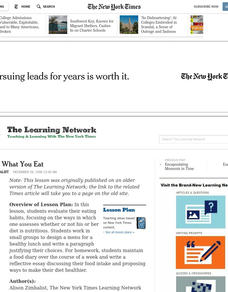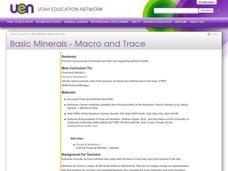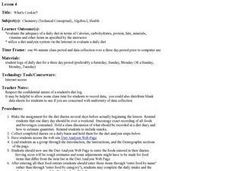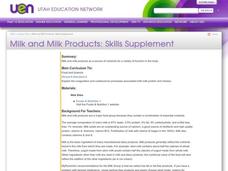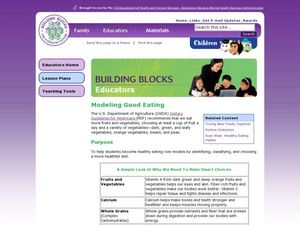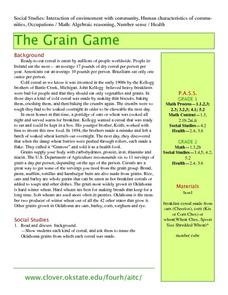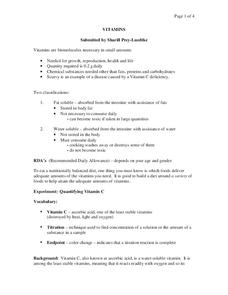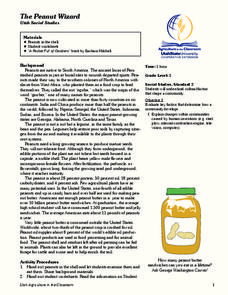Curated OER
Trophic Ecology of Humans
Students analyze the trophic level of humans by first calculating the kilocalories in own their lunch. They then calulate the kilocalories in a wide variety of foods found in grocery stores and compare the kilocalories needed to acquire...
Curated OER
Protein - Complete and Incomplete
The relationship between how an individual looks and feels and the nutrients he or she eats. Identify proteins (complete and incomplete), their sources, and functions in the body. National Standard 14.2.1 Define amino acids, complete and...
Curated OER
Computation: How can we use rice to solve problem questions?
Fourth graders graph metric tons of rice produced by various countries. In this graphing lesson, 4th graders follow problem solving steps to answer questions about rice nutrition and then graph the amount of rice produced by...
Curated OER
You Are What You Eat
Students evaluate their eating habits, focusing on the ways in which one assesses whether or not his or her diet is nutritious. They work in small groups to design a menu for a healthy lunch and write a paragraph justifying their choices.
Curated OER
Milk: A Practical Application
Explain the coagulation and coalescence processes associated with milk protein and cheese. List the components of milk and explain how each component is dispersed in the milk. Describe what happens when milk protein is coagulated Discuss...
Curated OER
Basic Vitamins: Water-Soluble and Fat-Soluble
Students examine vitamins and study their functions and food sources. They research what happens to vitamins when foods are overcooked. They prepare a microwaveable vegetable quiche.
Curated OER
Basic Minerals - Macro and Trace
Identify minerals, their sources, functions, and deficiencies in the body. National Standard 14.2.1 Discuss macro minerals, electrolytes, and trace minerals Identify the problems associated with calcium and iron
Curated OER
Composting
In this recognizing items that can be composted worksheet, students identify organic items that can be composted, write items that can be composted for each of the letters in the word compost, and make a list of vegetables and fruits....
Curated OER
Photosynthesis
In this biology worksheet, students explain where the energy of food originally came from. Then the explain one of the principal chemical compounds that living things use to store energy. Students also describe how ATP and ADP differ and...
Curated OER
What's Cookin'?
Learners examine their eating habits. In this nutrition lesson, students will journal their eating habits over a period of three days. They will use a diet analysis web page to determine the nutritional factors of their eating habits.
Nemours KidsHealth
Healthy Snacking: Grades 3-5
Learners investigate healthy snack foods. In this healthy snack foods lesson, students discover what good snacks consist off and how healthy snacking can improve health. They design the perfect snack machine using the associated...
Curated OER
Milk and Milk Products: Skills Supplement
Explain the coagulation and coalescence processes associated with milk protein and cheese. List the components of milk and explain how each component is dispersed in the milk. Describe what happens when milk protein is coagulated Discuss...
Curated OER
Learning About Plants- Flowers for a Special Occasion
Students explore the parts of plants and discover that plants need to grow. In this plant lesson, students discuss the parts of the plant and plant petunias. Students can share their plants with friends or families.
Curated OER
Modeling Good Eating
Students identify and classify the items in a healthy diet. In this dietary lesson, students listen to a song about healthy eating while listening for good snack foods. They use pictures of the snacks to complete a large chart by...
Curated OER
The Grain Game
Students read and discuss origin of cereal, use pieces of cereal made from grains grown in Oklahoma to play counting game, name their favorite breakfast cereal, guess which grains are used to make their favorite cereals, and read...
Curated OER
The Wheat Plant
Students sequence stages in the life of a wheat plant. They identify the six main parts of the wheat plant. They plant some kernels of wheat in the classroom so students can watch the growth and development. They record the plant's...
Curated OER
Vitamins
High schoolers determine the amount of vitamin C present in 3 samples of juice stored in various light conditions. In this vitamin lesson plan, students investigate the amount of vitamin C present in juice exposed to different quantities...
Curated OER
Chloroplasts and Mitochondria
For this biology worksheet, students read about the mechanism of photosynthesis to answer 43 short answer questions. They explain the role of chloroplasts in the process.
Curated OER
The Discovery of Photosynthesis
Students explore how scientists discover photosynthesis. In this biology lesson, students identify the basic requirements for photosynthesis to happen. They recreate past scientists' experiments and record their observations.
Curated OER
Body Parts, Systems & Functions
In this body parts worksheet, students match words to definitions, categorize organs into systems, name functions of organs, and more. Students complete 5 activities.
Curated OER
Quick Breads: A Practical Application
Apply food selection and preparation guidelines related to quick breads, rice, grains, and pasta. National Standard 14.3.3 Identify basic cooking techniques related rice, grains, and pasta Identify examples of quick breads: muffins,...
Curated OER
What Happens When You Eat?
Learners explore digestion. In this Human Body lesson plan, students participate in six different activities pertaining to the Digestive System. Learners gain understanding of digestion through experimentation and investigation. Students...
Curated OER
Mini-Ponds
In this mini pond worksheet, students create a mini-pond ecosystem with soil, water, and plant life. Students let their ecosystem sit for a day and they observe a sample the next day. Students identify all the pond water microorganisms...
Curated OER
The Peanut Wizard
Students investigate the history of the peanut. In this social studies instructional activity, students read the book A Pocket Full of Goobers and examine the a peanut. Students discuss the peanut's characteristics and take notes on an...



